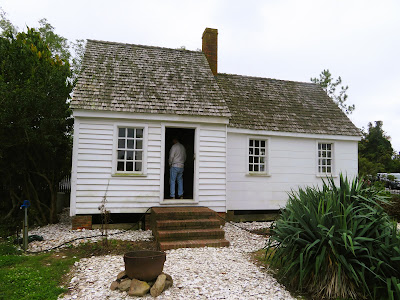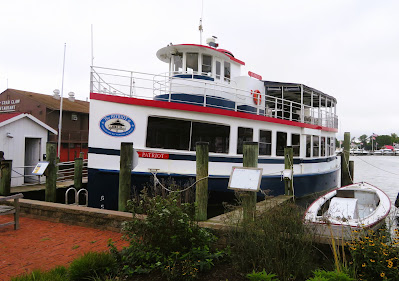St. Michaels offers a variety of activities and attractions. In my original planning for this family road trip, I’d listed a number of possibilities for our little group. The Chesapeake Bay Maritime Museum, located along St. Michaels’ waterfront was high on the list.
The impressive
Dodson House is located along the waterfront on the museum’s property. This 3-story brick structure was originally
built as a story and a half house ca 1851 by Thomas Dyott. In 1886 hotelier Richard Stearns Dodson expanded
the home…adding that triple deck porch…and started renting it out to summer
visitors. At one point Dodson planned on
turning it into a hotel, but neither he nor his son ever did. It continued as a residence for the family
for many years.
Another eye-catching
home located on the Museum’s property is the “Eagle House”. It was built on the site of a former steam
powered saw and grist mill…which was rebuilt twice due to fire and
explosions. The Dodson family acquired
the site in 1893 and this home was built on it.
The entry tower of the structure is capped by a golf eagle… The original
eagle for the home probably came from the top of a steamboat or tugboat pilot
house ca 1907. That’s a logical
conclusion since this once was the home of retired steamboat captain Edward
Napoleon Dodson.
This more
modest home was built ca 1856. The
Higgins house was named after its last owner before it was acquired by the museum. The double porch with sawn baluster and
bargeboard ornamentations were added in 1886 when the house was owned by the
Dodson family and was used for summer vacation rentals.
These 3
homes have stood along the St. Michaels waterfront for over 130 years now. Back in the day the harbor would have been
crowded with oyster tonging skiffs and canoes to large commercial sailing
vessels. The Dodson family also operated
a steamer, the “Olive”, to bring visitors across Chesapeake Bay to visit the
town… Twice each week a steamboat would arrive from Baltimore. Today these harbor side homes are being
preserved by the Chesapeake Bay Maritime Museum as their administrative
offices.
This is a 2007 replica of the shallop used more than 400 years ago by Captain John Smith from Jamestown Virginia. He used a modest boat like this one to explore the Chesapeake Bay and its many tributaries. In the 1600s, a “slallop” was an open wooden workboat or barge that was small enough to row but which also could be fitted with a sail or two.
Captain
Smith’s shallop was probably about 30 feet long and 8 feet wide but it probably
only drew less than 2 feet of water.
This was critical as so many of the tributaries are quite shallow. On the other hand, Smith described his boat
as an ‘open barge’ that could carry up to 3 tons of cargo. This replica was built to help celebrate
Captain Smith’s exploratory accomplishments...
This was
the former home of Eliza Bailey Mitchell.
She was abolitionist Frederick Douglass’ closest sibling. The left portion of the home was built in the
early 1800s and the right portion was built by the museum to resemble the
original/typical parlor and hall style home of the era. The home has been restored and refurbished to
help interpret the lives of both enslaved and free Black laborers…through the
lives of the Bailey-Mitchell family and Douglass.
Frederick
Baily aka Douglass lived in St. Michaels in the mid-1830s. He and his sister, Eliza, were both enslaved
by Mr. and Mrs. Thomas Auld. Eliza was
Frederick’s friend, playmate and teacher.
Eliza and her husband Peter, a free Black man, lived in this home for
many years. It had stood on the Perry
Cabin Farm owned by the Hambleton family.
Peter had previously been enslaved by the Hambleton’s.
Another
small home is this log house. It sits in
the middle of the Museum’s Heirloom Garden.
It was past the growing season but it was still interesting. Volunteers maintain these gardens which
feature rare, unique and historically accurate plants and herbs. Segments of the garden include a tobacco bed,
17th, 18th, 19th and 20th century
beds, plus a nature bed and an herb bed.
A local Eagle Scot planted yet another bed which contains flowers that
attract bees and other pollinators…
The
plantings in these garden plots have been extensively researched and they
reflect the kitchen and medicinal gardens that were cultivated by Indigenous
Americans, enslaved and free Africans as well as by white Europeans who lived
in the area over the centuries.
If you
would like to see a list of the plants that are included in the various garden
plots, just go to Heirloom-Garden-Plant-List-Aug2020.pdf (cbmm.org).
This
unusual looking structure is the top portion of the former Hooper Strait
Lighthouse. The lighthouse was built in
1879 to help guide boats trying to navigate the shallow and dangerous shoals of
Hooper Strait. The strait provides a
passage for boats from Chesapeake Bay across Tangier Sound and other locations
along the Nanticoke and Wicomico Rivers.
The boat
in front of the lighthouse is the H.M.
Krentz. She is an authentic working
skipjack. She is one of the newer
vessels built for Maryland’s wintertime commercial oyster dredging
fishery. She is 70 feet long, carries
about 2,000 square feet of sail and she was built in 1955. That wide open deck is necessary for for
oyster dredging under sail. Off season,
the H.M. Krentz provides tours and
she can also be chartered. To learn
more, go to Skipjack Tours | Sail the Chesapeake Bay Aboard The Historic
Skipjack H.M. Krentz (oystercatcher.com).
The old
Hooper Strait Lighthouse is a ‘screwpile’ lighthouse. It was built on special iron pilings which
were tipped with a screw that could be turned into the muddy bottom of the bay
or estuary to a depth of 10 feet or more.
This is the second lighthouse that served boaters at Hooper Strait. Ice destroyed the first on in 1877. By 1966 structural deterioration and
automation led to the Coast Guard to plan its razing. With help from others, the Museum stepped in
to save the structure.
The bell
tower to the right of the lighthouse was originally located in Scotland
Maryland where the Potomac River meets the Chesapeake Bay. The Point Lookout lighthouse and this bell
tower both served to warn sailors of the perils in the area. When fog hides a lighthouse’s beacon, bells
provide an audible signal to guide them.
Big bells like this one…1,100 pounds…provide warnings that carry for a
long distance. This bell tower was
originally constructed ca 1884. In 1965
the US Coast Guard closed the Lighthouse and fog bell tower. The bell tower was relocated to the museum in
1968.
This is a
view from the lighthouse which shows the Chesapeake Bay Maritime Museum’s working
shipyard. At one time the shoreline of
Chesapeake Bay was littered with scores of small shipyards where shipwrights
built and maintained scores of wooden boats and larger vessels. These shipyards and their skilled shipwrights
provided a huge boost to the areas commercial growth…while continuing the
skills needed to build seaworthy wooden water craft. Of course, over the decades most of these
shipyards and their skilled craftsmen no longer exist.
The
Museum’s working shipyard preserves and continues the mission of a working
waterfront. Chesapeake Bay Maritime
Museum’s shipwrights and their apprentices preserve and maintain the museum’s
floating fleet of Chesapeake Bay vessels as well as its historic small boat
collection. The Shipyard also offers
hands-on education programs and it provides construction, care and preservation
of historic boats for other organizations and clients.
This
second view from the historic Hooper Strait Lighthouse gives visitors a glimpse
of 2 important museum display buildings.
The structure to the right features “At Play on the Bay”. It provides a timeline and exhibits that show
one of the most dramatic changes in Chesapeake Bay’s uses over the past
century. It has gone from a waterway
that was primarily a place to work to a place where people come to play.
The building
at the left of the photo features the “Small Boat Shed and Maryland Crabmeat
Company”. Once located in Crisfield
Maryland, the Maryland Crab Meat Company was one of the state’s largest
crabmeat packing operations. In addition
to information about the crab meat business, the shed features a number of
skiffs and small boats used in the Chesapeake Bay fishery.
FYI...the land based 'boat' in front of the building at the right is the Thor. Kids can play in Thor's wheelhouse. This boat was actually built in 1912.
Why did I include this photo in a post about a maritime museum? Mostly because I like boats and yachts and it was dockside at the museum. Perhaps it was there for the wedding that was being set up on the property next to the harbor. In any case, the 70 foot long “Steel Away” motor yacht was recently spotted in the Caribbean Sea at Vessup Bay in the US Virgin Islands. I like the design of these ‘older’ yachts so much better than the sleek new ones…
Actually part of the broad offerings from the Chesapeake Bay Maritime Museum, the tour boat “Patriot” is a replica of the type of steam ferries that brought visitors to St. Michaels from across the bay in the 1930s. This ship is 65 feet long and 26 feet wide. The “Patriot” and her crew provides narrated historical cruises…weekends during ‘off season’ when we were there but daily seven days a week ‘in season’.
The
70 minute historic cruises along the Miles River provide visitors with views of
historic mansions, estates and wildlife. Fares for visitors in April of 2024 are as
follows: adults - $27.50; seniors - $25.00.
The rates for children are two-tiered…more for teenagers and less for
the younger set. To learn more, just go
to https://www.patriotcruises.com/.
In the next post,
we’ll take a lunch break and then in subsequent posts I’ll begin exploring the exhibits at the
museum, both those in the buildings shown, and those actually on the water.
Just click on any
of the photos to enlarge them…
Thanks for stopping
by for a visit!
Take Care, Big
Daddy Dave












The view from the lighthouse looks gorgeous and I really love the Dodson House. I have heard that the most houses in the states are built with woods, not cement. Is that still true?
ReplyDeleteDave, reading more about your visit to St Michaels has me thinking that if we should ever take a road trip back to the Eastern Shore than we should definitely plan a stop.
ReplyDeleteLindas casas pero mis dos favoritos son el museo y el faro. Te mando un beso.
ReplyDelete